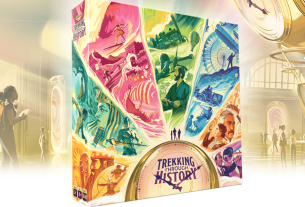 A few years ago I stumbled upon a iOS app called Ascension: Chronicle of the Godslayer (available on iTunes and Google Play). It looked to be an interesting deck building game, but as I only owned an iPod touch at the time, the minuscule card text threatened to render me blind before I’d mastered the game. A bit of digging revealed that the game was based on a physical counterpart. The original boxed game was difficult to track down in the UK but, eventually, I managed to do so.
A few years ago I stumbled upon a iOS app called Ascension: Chronicle of the Godslayer (available on iTunes and Google Play). It looked to be an interesting deck building game, but as I only owned an iPod touch at the time, the minuscule card text threatened to render me blind before I’d mastered the game. A bit of digging revealed that the game was based on a physical counterpart. The original boxed game was difficult to track down in the UK but, eventually, I managed to do so.
This led to many pleasing hands of an easy to learn, fun to master, deckbuilder. Better yet, my son grasped it too, and we had great fun playing together. Roll on a few years, now my oldest two (7 & 10), can be heard playing against one another without any adult intervention (albeit with suspiciously one-sided results). Now, the Ascension series is in its tenth iteration. I have the first three versions of the game, and have had the opportunity to try out the newly released, Ascension X: War of Shadows.
So, how does version 10.0 compare? Well, the most apposite adage to describe the game is, “If it ain’t broke, don’t fix it.”
One of the biggest issues with a deck building game is that, eventually, with a finite number of cards, winning combinations become evident. Games become routine as the same cards are pulled out over and over again.
In order to combat this, publishers produce new cards which tweak the original ruleset. In some cases this can upset the balance of the game, or it can make games increasingly complicated, ruining the reason we enjoyed playing them in the first place. The flip-side of this coin are expansions that do very little. Those that just bring lots of new cards to spend your money on but barely alter the game or add anything to the playing experience. It’s a thin line to tread.
So, does Ascension: War of Shadows succeed? Mostly, yes.
The key to its success is a small, but fundamental, tweak to the rules, whilst adding a cohort of new cards into the fray. The basic game remains the same, but this being a War of Shadows, whether it’s “day” or “night” plays an important part.
Game Components:
The components of the game the same as previous iterations.
- A board. This is nice, but the game is perfectly playable without it, especially if you’ve played before.
- 177 Cards. One of the best things about Ascension are the illustrations. Again these are very good. Though they are now more generic fantasy type illustrations, rather than the stylized, angular pen and ink of the earlier games. Both are good.
- 50 Honor tokens. Plastic gems that are used to keep track of your score. Once you have a few sets you seem to have millions of the blighters.
- Rulebook. Pleasingly thin. Ascension is easy to pick up.
Game Overview:
In case you’ve never played Ascension before here is a quick overview, before I explain how War of Shadows differs from the base set.
Ascension is a game for 1-4 players. With more than one set it can be expanded to 6 players, though I’ve never done this. The more players you have, the longer the game takes.
At the start of a game, an honor pool is set up. This is usually 30 points per player. The aim of the game is to score as many honor points as possible. There are two main ways to score honor: by defeating monsters and collecting cards. Defeating monsters gives honor directly from the honor pool to the player who defeated the monster. Once the honor pool has been reduced to zero the game finishes. Defeating monster cards brings the game closer to the end.
Each player starts with a deck of the same 10 cards. 8 Apprentices and 2 Militia. These are shuffled and the top 5 drawn. The rest of the cards form the “Center Deck”, 6 of which lie face up to form the “center row.” It’s here where all the interesting stuff happens.

Heroes and artefacts (called constructs) can be purchased from the center row, using “runes.” Monsters are defeated by “power.” Apprentices can generate 1 rune each, and militia, 1 power, so your options at the beginning of a game are fairly limited.
As you purchase hero cards, they are discarded, along with the cards used to purchase them. When you reach the bottom of your deck, (for the first time this is after only two rounds, since you start with 10 cards), you shuffle all the cards together and place them face down to form a new deck. You make a new hand by dealing off the top 5. This will hopefully hold some of your shiny, newly purchased, cards.
If you can’t purchase anything from the center row, there are two standard cards that can be purchased all the time (though they can run out later in the game), the Mystic and the Heavy Infantry – these cards give 2 runes/power respectively, and will help you build up your card stocks so that you can buy/defeat more interesting cards from the center row.
Cards in the center row each have special ability. Generally speaking, the more it costs to buy, the better a card’s abilities are. Hero/construct cards also have an honor value, which is used to calculate the honor total at the end of the game. Again, the higher a card’s cost, the more honor it will give you. Once purchased new cards go into your discard pile, waiting to be shuffled when you form your new deck. Next time they appear, you’ll be able to use their powers to help you progress in the game.
The key difference between monsters and heroes is that when you defeat a monster, it is not placed in your discard pile. Instead it is sent to the “void” (in essence a monster discard pile). More powerful monsters need more power to defeat them, but give better honor rewards when you do so. Monsters often give a one off benefit to the player who defeated them.
As play continues, decks become increasingly powerful, and turns increasingly complex, as different combination of cards produce different and complementary effects. When the honor pool has run dry, the game is over. The winner is the person who has the most honor, including that earned by killing monsters and honor values of your hero cards.
Playing the base game is a pleasing experience. There are lots of tactics in building up card combinations, and working out which cards play well with others. If the game has a weakness, it’s that once these combinations have been learned, games can become processional. Also, sometimes it can be obvious from early on that you have fallen behind and are never going to catch up.
How is War of Shadows different?
Later installments of Ascension, bring in ways to vary the game, such as conditions that alter how cards are resolved. War of Shadows contains such a device, in the form of an extra card attribute. “day” or “night.” This attribute is relevant only when the cards are in the center row. If there are more day cards, then it’s considered to be daytime, more night cards, then the sun has set. (If there are three of each, it’s neither day nor night.)
The relevance of this? Some monster or hero cards have additional effects depending on whether it’s night or day. For example, one card allows you to draw one card when played, but also an additional card if it’s daytime. There is also a monster which requires a staggering 10 power to defeat, but this is halved in the daytime. Day cards are placed above center line, night cards below, making it relatively easy to tell at a glance whether the game is in light of shadow.

Since cards in the Center Row are replenished as soon as you take them, night and day can change during your turn. It’s important to remember this as you are deciding what to do. Carefully constructed plans can come unstuck as valuable resources become unavailable due to a change in phase. It’s not often a complete switch occurs, but with a three-three split causing neither night nor day, losing those all important bonuses is often only a flip of a card away.
This fairly simple mechanic change adds a layer of tactical complexity that improves the game.
Age of Shadows also introduces dual points cost cards. These are cards that require both runes and power to obtain. This doesn’t change the game very much, but some of these cards can be difficult to bring out of the center row, which can cause a bottleneck. Look out for cards that allow you to obtain new cards of a certain rune value or below. These can also be used to capture dual cost cards. The power value is completely ignored in these cases, making their easy acquisition a bargain.
I’m less keen on the “Trophy” monsters. I don’t think they were newly introduced in War of Shadows, but these are the first time I’d see them. These are monsters that instead of being banished to the void when you defeat them are placed next to your deck, where they wait to be used. Trophy monsters generally give small one shot boons that can be used at any time. The problem with them is that they are easy to forget and, personally, I don’t think they add much to the game.
There are some issues with the increased complexity. In the throes of a complicated turn, it is possible to forget which cards you’ve played or how many runes you have left to spend. It’s here that the app versions come into their own. With a computer to keep tally of the score and available purchases, it leaves you free to work on the tactics. Nevertheless, I much prefer the tactile social experience of gathering around the table with friends.
The Verdict:
The Ascension series is now well established. It provides an entertaining deck-building duel experience without the money draining powers of collectible card games like Magic: The Gathering. The game is simple to play for adults and children and has a tactical depth that takes time to master.
If you have never played the game before, I wouldn’t necessarily recommend War of Shadows to new players. If you haven’t played before, head for the original. If you are familiar with the game but have tapped out the playing potential of your current set, War of Shadows definitely reinvigorates the game. The new day and night mechanic adds an additional layer of complexity without reducing its accessibility. On the last few mornings, I’ve come downstairs to find my boys thoroughly enjoying a game War of Shadows, proving that the game’s essential simplicity is still there. The changes aren’t radical, but they do enough. Ascension wasn’t broke, Stoneblade haven’t fixed it. They’ve just changed it to be, “Same, same, but different“.
Disclaimer: I was sent a copy of “Age of Shadows” in order to write this review.



